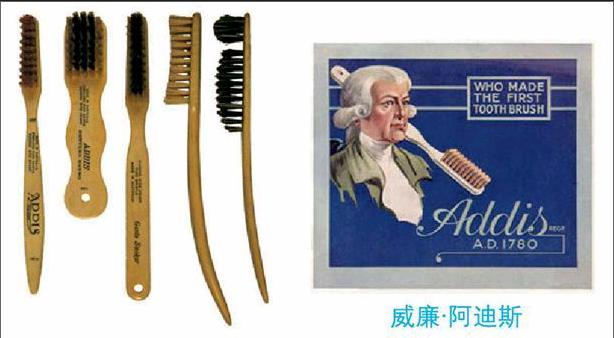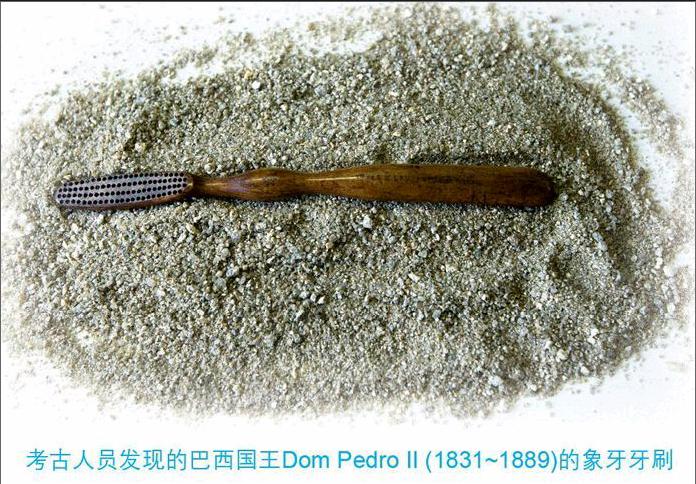牙刷和牙膏的前世今生
2014-03-12Fromcolgate.com
From+colgate.com



History of Toothbrushes 牙刷的历史
Toothbrushing tools date back to 3500~3000 BC when the Babylonians and the Egyptians made a brush by fraying1) the end of a twig. Tombs of the ancient Egyptians have been found containing tooth sticks alongside their owners. Around 1600 BC, the Chinese developed "chewing sticks" to freshen breath which were made from aromatic2) tree twigs.
The Chinese are believed to have invented the first natural bristle3) toothbrush in the 15th century, made from the bristles from pigs' necks attached to a bone or bamboo handle. When it was brought from China to Europe, this design was adapted and often used softer horsehairs, which many Europeans preferred. Other designs in Europe used feathers.
The first toothbrush of a more modern design was made by William Addis in England around 1780—the handle was carved from cattle bone and the brush portion was still made from swine4) bristles. In 1844, the first 3-row bristle brush was designed.
Natural bristles were the only source of bristles until DuPont5) invented nylon. The invention of nylon started the development of the truly modern toothbrush in 1938, and by the 1950s softer nylon bristles were being made, as people preferred these. The first electric toothbrush was made in 1939 and the first electric toothbrush in the US was the Broxodent in 1960.
Today, both manual and electric toothbrushes come in many shapes and sizes and are typically made of plastic molded handles and nylon bristles. The most recent toothbrush models include handles that are straight, angled, curved, and contoured6) with grips and soft rubber areas to make them easier to hold and use. Toothbrush bristles are usually synthetic7) and range from very soft to soft in texture8), although harder bristle versions are available. Toothbrush heads range from very small for young children to larger sizes for older children and adults and come in a variety of shapes such as rectangular, oblong9), oval and almost round.
The basic fundamentals have not changed since the times of the Egyptians and Babylonians—a handle to grip, and a bristle-like feature with which to clean the teeth. Over its long history, the toothbrush has evolved to become a scientifically designed tool using modern ergonomic10) designs and safe and hygienic materials.
刷牙工具的出现最早可以追溯到公元前3500~3000年,当时古巴比伦人和古埃及人通过磨散小树枝的末端将其制成牙刷。在古埃及人的墓中曾发现墓主的身边摆放着牙签。公元前1600年左右,中国人开发出由带香气的树枝做成的“咀嚼棒”来清新口气。
人们普遍认为是中国人在15世纪时发明了第一把用天然鬃毛做的牙刷——将一撮猪颈部的鬃毛固定在骨头或是竹子制成的手柄上。这种牙刷从中国传到欧洲后,样式有所改变,通常会使用许多欧洲人喜欢的更为柔软的马鬃。当时欧洲也有一些其他的用羽毛制成的牙刷。endprint
威廉·阿迪斯于1780年左右在英格兰设计出了第一支较为现代的牙刷——牙刷柄由牛骨雕刻而成,刷毛部分则仍由猪鬃构成。1844年,第一支三排毛的牙刷面世。
在杜邦公司发明尼龙之前,天然鬃毛一直是牙刷毛的唯一原料。1938年,尼龙的发明开启了真正意义上的现代牙刷的发展之路。到20世纪50年代,应人们的偏爱,用更为柔软的尼龙制作成的牙刷毛诞生了。1939年,第一支电动牙刷问世。美国的第一支电动牙刷则是1960年诞生的Broxodent电动牙刷。
现在,不论是普通牙刷还是电动牙刷都有多种外形和尺码,通常都是由塑料柄和尼龙毛构成。最新的牙刷样式包括手柄是直线型的、有角度型的、曲线型的和波浪线型的,并附有把手和用软质橡胶覆盖的部位,这样易于抓握和使用。牙刷毛则通常是人工合成的,质地从非常软到柔软都有,不过也有较硬的牙刷毛。牙刷头从专为婴幼儿设计的特小号,到年龄大一些的孩子和成年人使用的较大号,大小都有。牙刷头的形状也多种多样,有矩形、长椭圆形、椭圆形,还有接近圆形的。
从古埃及人和古巴比伦人的时代至今,牙刷的基本结构始终没变——供抓握的手柄和用来清洁牙齿的类似鬃毛的部分。在经过漫长的历史演变后,牙刷已经逐步成为一种设计科学合理的工具,采用现代人体工程学设计并且用材安全又卫生。
History of Toothpastes 牙膏的历史
Egyptians are believed to have started using a paste to clean their teeth around 5000 BC, before toothbrushes were invented. Ancient Greeks and Romans are known to have used toothpastes, and people in China and India first used toothpaste around 500 BC.
Ancient toothpastes were used to treat some of the same concerns that we have today—keeping teeth and gums clean, whitening teeth and freshening breath. The ingredients of ancient toothpastes were however very different and varied. Ingredients used included a powder of ox hooves' ashes and burnt eggshells that was combined with pumice11). The Greeks and Romans favored more abrasiveness12) and their toothpaste ingredients included crushed bones and oyster shells. The Romans added more flavoring to help with bad breath, as well as powdered charcoal13) and bark14). The Chinese used a wide variety of substances in toothpastes over time that have included ginseng15), herbal mints and salt.
The development of toothpastes in more modern times started in the 1800s. Early versions contained soap and in the 1850s chalk was included. Betel nut16) was included in toothpaste in England in the 1800s, and in the 1860s a home encyclopedia17) described a home-made toothpaste that used ground charcoal.
Prior to the 1850s, "toothpastes" were usually powders. During the 1850s, a new toothpaste in a jar was developed and in 1873 Colgate started the mass production of toothpaste in jars. Colgate introduced its toothpaste in a tube similar to modern-day toothpaste tubes in the 1890s.
In the second half of the twentieth century modern toothpastes were developed to help prevent or treat specific diseases and conditions such as tooth sensitivity. Fluoride18) toothpastes to help prevent decay were introduced in 1914. Toothpastes with very low abrasiveness were also developed and helped prevent the problems caused by overzealous19) brushing.endprint
The most recent advances in toothpastes have included the development of whitening toothpastes, and toothpaste containing triclosan which provides extra protection against bad breath and dental diseases like caries20).
Toothpastes today typically contain fluoride, coloring, flavoring, sweetener, as well as ingredients that make the toothpaste a smooth paste, foam, and stay moist. Individual toothpastes also may contain special ingredients, such as triclosan. Toothpaste in tubes is used throughout the world and has been a very successful invention.
人们普遍认为早在牙刷发明之前,古埃及人就已在约公元前5000年率先使用一种膏状物来清洁牙齿。古希腊人和古罗马人也用过牙膏,中国人和印度人最早在公元前500年左右开始使用牙膏。
古时的牙膏用途有一些跟现在一样——保持牙齿和牙龈的清洁,亮白牙齿,清新口气。然而古时的牙膏成分跟现在的有很大区别,并且多种多样。古时的牙膏成分包括牛蹄骨灰粉、烧过的蛋壳与浮石的混合物。古希腊人和古罗马人更喜欢用有研磨性的牙膏,他们的牙膏成分包括磨碎的骨头和牡蛎壳。为防治口腔异味,古罗马人在牙膏中加入了更多香料以及木炭粉和树皮屑。中国人随着时间的推移曾用过各种各样的物质制作牙膏,其中就有人参、薄荷和盐。
牙膏在近现代的发展开始于19世纪。早期的牙膏成分里含有肥皂,到19世纪50年代又加入了白垩粉。19世纪,英国的牙膏中加入了槟榔。19世纪60年代,英国的一本民用百科全书记录了一种家庭自制的牙膏,其成分中包括木炭粉。
在19世纪50年代以前,“牙膏”通常都是粉状的。19世纪50年代,一种新型罐装牙膏诞生。1873年,高露洁开始大规模生产罐装牙膏,在19世纪90年代,高露洁将一种管装牙膏引入市场,其形状类似于现在的牙膏管。
20世纪后半叶,人们发明了现代牙膏来帮助防止或治疗某些特定的疾病和症状,如牙齿敏感。1914年,可以防龋的含氟牙膏问世。人们还开发了研磨作用轻微的牙膏,它的出现有助于防止刷牙过度引起的牙齿问题。
牙膏发展的最新进展包括开发出美白牙膏以及含三氯生成分的牙膏,这种牙膏可以为牙齿提供额外保护,以防止口腔异味以及龋齿等牙齿疾病。
现在的牙膏中通常含有氟化物,色素,芳香剂,甜味剂以及其他能使牙膏呈均匀的糊状物、产生泡沫并保持湿润的成分。个别牙膏可能还含有一些特殊成分,如三氯生。现在,管装牙膏已在全世界范围使用,成为一个非常成功的发明。
1. fray [fre?] vt. 磨散(织物等的)边缘(或末端)
2. aromatic [??r??m?t?k] adj. 芳香的,有香味的,有香气的
3. bristle [?br?sl] n. 猪鬃毛;刷子毛
4. swine [swa?n] n. 猪
5. DuPont: 杜邦,世界排名第二的美国化工公司,成立于1802年,领导了20世纪的聚合物革命,开发了很多极为成功的材料。
6. contoured [?k?nt??d] adj. 波状外形的
7. synthetic [s?n?θet?k] adj. 合成的;人造的
8. texture [?tekst??(r)] n. 质地
9. oblong [??bl??] adj. 长椭圆形的
10. ergonomic [???ɡ??n?m?k] adj. 工效学的,人体工程学的
11. pumice [p?m?s] n. 浮石,浮岩,轻石(用于去垢、磨光等;亦作pumice stone)
12. abrasiveness [??bre?s?vn?s] n. 研磨
13. charcoal [?t?ɑ?k??l] n. 炭,木炭
14. bark [bɑ?k] n. 树皮;茎皮
15. ginseng [?d??nse?] n. 人参
16. betel nut: 槟榔子;槟榔果
17. home encyclopedia: 指流传于17~19世纪的英国和美国的一种百科全书,现已不再使用。其内容包罗万象,被很多家庭用来了解和增长知识,但与现在的百科全书有所不同,其中又不乏各种专业知识,因此并不仅限于家庭使用。
18. fluoride [?fl??ra?d] n. 【化】氟化物
19. overzealous [???v??zel?s] adj. 过分热心的
20. caries [?ke?ri?z] n. 【医】龋
译 / 阿琼endprint
